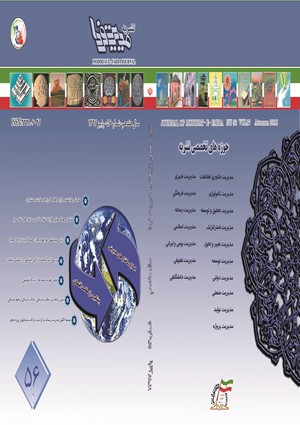A model for change governance structures for implementation theocracy based velayat-e faqih
Subject Areas :
1 - Humanities Faculty, Yadegar-e-Imam Khomeini (RAH) Shahre Rey Branch, Islamic Azad University, Tehran, Iran
Keywords: Theocracy, theocracy structure, urban management, neighborhood management, clerical,
Abstract :
The Iranian people, led by Imam Khomeini revolted for the establishment of Islamic rule. Today the world's dominant discourse is democracy and for this purpose, the nature of the government of Iran became Islamic Republic that democracy is form and Islamic is terms of content of government. Due to the lack of experience of Islamic countries in democratic, western systems of governance was accepted to implement democracy. For Islamization of the government, it placed the Supreme Leader at the head and the Guardian Council supervisory of parliament. Now, after nearly four decades is essential to be revised in the governance structures. If there is a fault in the system should be desgined a system based on religious approch and according to the conditions implement that in the absence of Imam Islamic roles should be implemented. The study based on religious principles, characteristics of Islamic government and conditions of our country a model for implementing religious government is designed. Content analysis method is used to obtain principle that should be considered in the design of governance structures. For finding religious (Islamic) government a questionnaire among 30 people who were selected snowball was distributed and analyesd with AHP method. For the realization of these features according to religious principles and features of Iranian people, a system was designed that accordind to the idea of ten of experts was revised. Keywords: neighborhood management, theocracy, theocracy structure, urban managementthe supreme leader.
منابع
قرآن کریم
نهجالبلاغه
اسدی, محمد رضا. “عجله و شتاب عامل ۷۰ درصد تصادفات رانندگی در ایران.” شهروند دردمند. ۲ فروردین ۱۳۹۰. http://mrasadi.ir/38/ (دستيابی در آذر ۳۰, ۱۳۹۵).
آصفی, محمد مهدی. مبانی نظری حکومت اسلامی (بررسی فقهی تطبیقی). با ترجمه محمد سپهری. تهران: مجمع جهانی تقریب مذاهب اسلامی, ۱۳۸۵.
خامنهای, سید علی. بیانات در دیدار اعضای مجلس خبرگان رهبری. ۱۷ شهریور ۱۳۹۰. http://farsi.khamenei.ir/speech-content?id=17226 (دستيابی در دی ۱۵, ۱۳۹۵).
خبرگزاری تابناک. واکنش همزمان ۵ مرجع تقلید به «نظام بانکی ربوی» . ۲۹ آذر ۱۳۹۵. http://tabnak.ir/fa/news/649512 (دستيابی در آذر ۲۹, ۱۳۹۵).
—. ورود بیش از 14 میلیون پرونده به قوه قضائیه. ۸ تیر ۱۳۹۵. http://www.tabnak.ir/fa/news/601380 (دستيابی در آذر ۲۹, ۱۳۹۵).
خبرگزاری فرارو. ایران در رتبه ۱۳۶ «شاخص فساد» جهانی قرار گرفت. ۱۲ آذر ۱۳۹۳. http://fararu.com/fa/news/215767 (دستيابی در آذر ۲۹, ۱۳۹۵).
دلشاد تهرانی, مصطفی. دولت آفتاب. تهران: دریا, ۱۳۷۹.
دیباجی, سید محمد علی. پیامبران دولتمرد: پژوهشی درباره مدلهای حکومت دینی در قرآن. تهران: مرکز پژوهشهای مجلس شورای اسلامی, ۱۳۸۷.
رازانی, محمد علی. نظام حکومت اسلامی. تهران: مام, ۱۳۸۱.
رشیدی, مینا. “سفرنامه نویسان فرنگی ایرانیان را دروغگو می پنداشتند.” پایگاه خبری تحلیلی دنیای سفر. ۲۶ دی ۱۳۹۴. http://www.donyayesafar.com/n/4271 (دستيابی در آذر ۳۰, ۱۳۹۵).
شاهدی, غفار. مبانی کلامی حکومت دینی. قم: معارف, ۱۳۹۰.
قوامی, سید صمصام الدین. نهضت خدمت رسانی (نظریه خدمت). چاپ دوم، تهران: معاونت فرهنگی شورای سیاستگذاری ائمه جمعه, ۱۳۸۷.
مرکز آمار ایران. چکیده یافتههای طرح آمارگیری گذران وقت در نقاط شهری - تابستان 1394. گزارش, تهران: مرکز آمار ایران, 1394.
مطهری, مرتضی. مجموعۀ آثار. چاپ هفتم. جلد 6. در لوح فشردۀ مجموعه آثار استاد شهید مطهری، قم: مرکز تحقیقات علوم کامپیوتری علوم اسلامی, بیتا.
مهدوی نور, سید حاتم. آیین زندگی در عصر مدرن. علی اباد کتول: دانشگاه آزاد اسلامی واحد علی آباد کتول, ۱۳۹۳.
مؤسسه مطالعات و پژوهشهای بازرگانی. ارتقاي بهره وري عامل رشد اقتصادي كشور. بیتا. http://www.itsr.ir/Newsletter/article/127/ (دستيابی در اسفند ۸, ۱۳۹۴).
نقی زاده, محمد. معماری و شهرسازی اسلامی (مبانی نظری). راهیان به کوشش سازمان نظام مهندسی ساختمان استان اصفهان, ۱۳۸۵.


